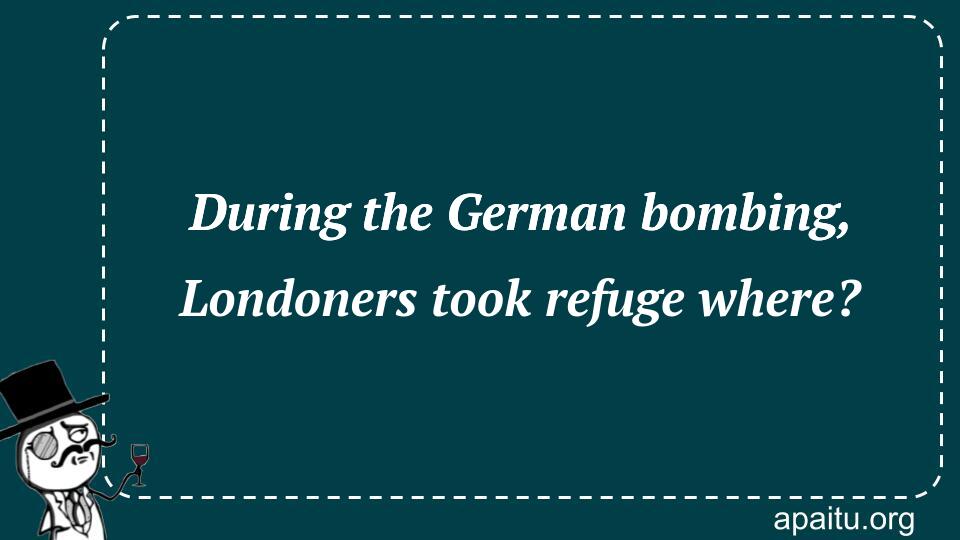Question
Here is the question : DURING THE GERMAN BOMBING, LONDONERS TOOK REFUGE WHERE?
Option
Here is the option for the question :
- The Underground
- The Thames
- Under London Bridge
- Buckingham Palace
The Answer:
And, the answer for the the question is :
Explanation:
The Blitz, or aircraft bombing raids on Britain, began on September 7, 1940, in London. The government first forbade civilians from using Underground train stations as shelter, but this did not deter many, and entire families gathered in the stations. The government eventually recognized the value of people hiding in the tunnels and offered facilities such as food, tea, lavatories, and entertainment.

Londoners and the Underground: Seeking Shelter during German Bombing
During the tumultuous years of World War II, the city of London faced relentless bombing campaigns by the German Luftwaffe. As sirens wailed and the skies rained destruction, Londoners sought refuge in the most unlikely of places—the Underground. The London Underground, commonly known as the Tube, became a vital sanctuary for the city’s residents, offering shelter, safety, and a glimmer of hope amidst the chaos and devastation.
The decision to use the Underground as a shelter during the war was born out of necessity. With the German bombing raids targeting strategic locations and civilian areas alike, the existing air raid shelters in London quickly proved insufficient to accommodate the growing number of people seeking protection. As a solution, the government and city officials turned to the vast underground network of tunnels and stations that comprised the London Underground.
The Tube stations offered several advantages as bomb shelters. The deep tunnels provided a reliable barrier against the relentless bombardment from above, shielding Londoners from the deadly rain of explosives. The sturdy construction of the stations, designed to withstand the pressures of underground transportation, offered a sense of security amidst the chaos and destruction taking place on the surface.
In response to the growing demand for shelter, the government and London Transport undertook significant preparations to make the Underground stations suitable for housing large numbers of people. Bunks, seating arrangements, and basic amenities were installed to provide some comfort and support for those seeking refuge. The stations were equipped with medical facilities to tend to the injured, and canteens were established to provide sustenance during the long hours spent underground.
The use of the Underground as a shelter during the bombings was not without challenges. The crowded conditions and limited facilities posed difficulties for those seeking refuge. The lack of privacy, ventilation, and sanitation facilities made life in the Underground far from ideal. However, Londoners displayed remarkable resilience and camaraderie, adapting to the circumstances and finding solace in each other’s company.
the Underground shelters played a crucial role in protecting Londoners during the war. The network of tunnels provided a safe haven for countless individuals and families, offering a respite from the constant fear and uncertainty that plagued the city. The Underground shelters became a symbol of defiance and resilience, a testament to the indomitable spirit of the people of London.
The Underground shelters were not only places of refuge but also hubs of community and solidarity. Londoners from all walks of life came together in the confined spaces of the Underground, forging bonds and supporting one another through the darkest days of the war. Neighbors became friends, strangers became allies, and the collective spirit of the city grew stronger in the face of adversity.
The endurance of Londoners during the German bombing raids and their use of the Underground as a shelter became a source of inspiration and admiration both at home and abroad. The resilience and determination displayed by the people of London during those challenging times left an indelible mark on the city’s history and the collective memory of its inhabitants.
the legacy of the Underground shelters lives on as a reminder of London’s wartime experiences. Some Tube stations still bear evidence of their wartime role, with plaques and memorials commemorating the bravery and sacrifices made by Londoners. The Underground’s contribution to the city’s survival during the war is a testament to the strength of community and the enduring spirit of resilience.
during the German bombing raids of World War II, Londoners sought shelter and safety underground in the city’s vast network of Tube stations. The Underground became a refuge for thousands of people, offering protection from the devastating airstrikes and a sense of community amidst the chaos. The resilience and determination displayed by Londoners during those dark times remain an integral part of the city’s history, reminding us of the power of unity and the unwavering spirit of those who endured the hardships of war.